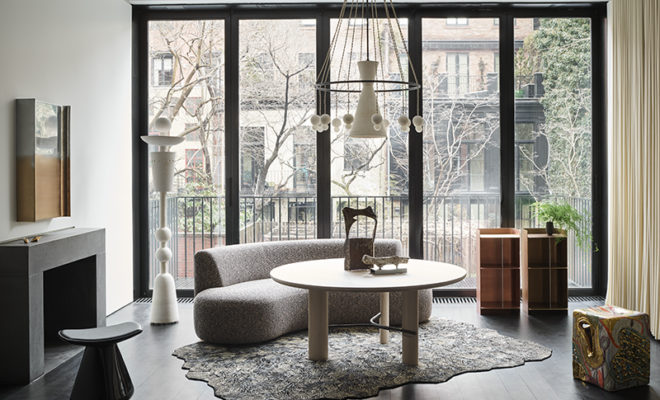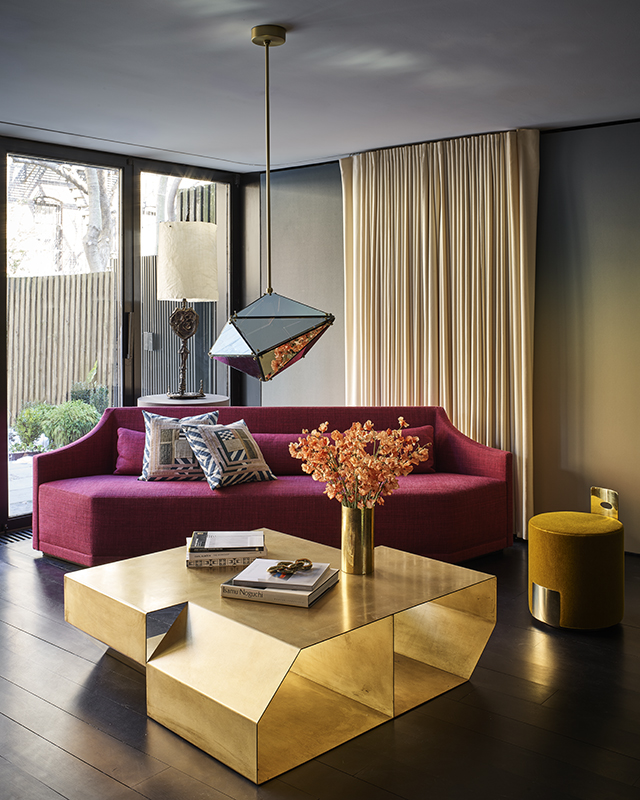 An Eric Roinestad chandelier above a Lek Sofa by Christophe Delcourt for Collection Particulière, with Drinks Cabinets by Marcin Rusack and a ceramic stool by Reinaldo Sanguino. DOUGLAS FRIEDMAN PHOTO.
An Eric Roinestad chandelier above a Lek Sofa by Christophe Delcourt for Collection Particulière, with Drinks Cabinets by Marcin Rusack and a ceramic stool by Reinaldo Sanguino. DOUGLAS FRIEDMAN PHOTO.
Design
Casa Perfect: A Home for Collectible Design
From the outside, the just-opened Casa Perfect is another perfectly lovely, quintessential Victorian townhouse, facing a small park in the West Village. But inside, it’s another story altogether—and a spectacular one. An extraordinary English Oak staircase by architect David Chipperfield rises in switchbacks from the basement to the top floor of a soaring five-story house, leading the visitor to a succession of spaces in which owner David Alhadeff has deployed inviting arrangements of collectible furnishings and objects. Some are custom-order, others are unique or limited-edition designs, and though many of the designers have been represented in his gallery, the Future Perfect, almost all of the pieces are new and specially selected for this venue.

Two large Poltrona chairs, 2006, by DIMORE STUDIO, underneath the Mobile Chandelier 13, originally designed in 2008, by Michael Anastassiades. DOUGLAS FRIEDMAN PHOTO.
Alhadeff is taking a different approach to marketing high-end design: a residential setting, available only by appointment, where designers and clients can visit comfortably, enjoy personal attention, and avoid the pressure of the typical selling environment. Having first road-tested the idea with considerable success in Los Angeles, where a glamorous Trousdale Estates residence once owned by Elvis Presley provided an altogether different background for modern design, he decided to bring Casa Perfect to New York. The search for a suitable venue wasn’t easy. “I wanted a space where we could treat clients like guests,” Alhadeff says. “It needed provenance and a story to tell. It had to have soul.”

A Charles de Lisle Linden Ivy light hangs almost forty feet through the townhouse. DOUGLAS FRIEDMAN PHOTO.
After two and half years, he came upon the townhouse, which had been completely gutted and modernized by Chipperfield and designer David Mlinaric as a bachelor residence conceived for entertaining. The light-filled interior has a central skylight and rear walls that feature windows opening to a spacious landscaped garden. Amenities include a stainless-steel kitchen with a wall of wine storage, wood-burning fireplaces, and a rooftop terrace. “It was strangely perfect for us,” Alhadeff says.

A D3 Inge Sofa by Lazzarini & Pickering for Marta Sala Éditions, a Maxhedron horizontal light by Bec Brittain for Roll & Hill, and a Chamfer table by Christopher Stuart. DOUGLAS FRIEDMAN PHOTO.
Showing art-furniture and avant-garde accessory objects in room-like settings rather than in the spare surroundings of a gallery or the cluttered confusion of a retail store enables prospective buyers to see how the designs will look in their homes. Extruded ceramic tables by Floris Wubben, brushed bronze and aluminum pieces by Marcin Rusack, and funky vases by Chris Wolston coexist comfortably with curvaceous sofas from Collection Particuliere. Built-in display shelves house traffic-stopping objects: Jonathan Cross’s brutalist ceramics, Nathalie du Pasquier and George Sowden’s Memphis-inspired pieces, and John Hogan’s luminous glass sculptures. Casa Perfect is also showing new unique and limited-edition pieces by Chris Stuart, Chen Chen and Kai Williams, Reinado Sanguino, Marta Sala, and others. One of the most arresting works in the townhouse is not for sale: Suspended in the center of the staircase, from the top floor to the lower level, is a 40-foot-long modular chandelier made from slim lengths of hexagonal brass stock, punctuated by globe bulbs, and designed specially for the space by Charles de Lisle.

A Moreau Bed by Pinch with Oceania Fathom wallpaper by Calico Wallpaper and a Crane 7 floor lamp by Bec Brittain. DOUGLAS FRIEDMAN PHOTO.
Alhadeff opened the Future Perfect in Brooklyn in 2003, as a retail store specializing in contemporary American design. At the time, little attention was being paid to design in this country, but he found a group of creative young designers, many working locally in the newly-gentrifying borough. As business grew, the store moved to Great Jones Street in Manhattan in 2009, and Alhadeff opened a San Francisco location in 2013. To accommodate the move into collectible design, he opened the first Casa Perfect in Los Angeles in 2017, which succeeded well beyond his expectations and prompted the decision to take the concept to New York—where, if the initial wave of enthusiastic press coverage and the volume of requests for appointments are any indication—will equal or surpass the West Coast results.
The idea of an art salon is not entirely new. As the cost of gallery space in New York has escalated, some small art dealers have been marketing their wares through modest exhibitions in residential settings, but Alhadeff’s venture is on a much grander scale. Every area of the multi-million-dollar townhouse functions as selling space, with all items available for purchase.

Big Mushroom lamps by Arnout Visser and two P5 Dudotta armchairs, 2017, by Lazzarini & Pickering for Marta Sala Éditions. DOUGLAS FRIEDMAN PHOTO.
In the age of internet buying, when retailers are struggling to entice consumers to leave their screens and come into brick-and-mortar spaces, the idea of shopping for furniture in someone’s home can be uniquely appealing. And Casa Perfect is, indeed, a home: “I’m going to live here,” Alhadeff explains, sounding as delighted as anyone might be at the prospect of living in a fabulous space with fabulous furnishings. And whenever something is purchased by an affluent guest, he’ll have another treasure ready to take its place.










